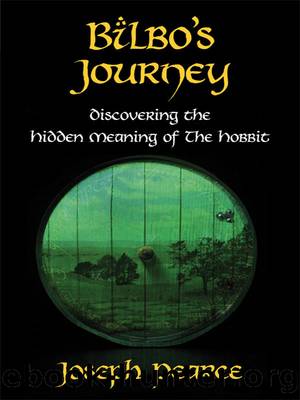Bilboâs Journey: Discovering the Hidden Meaning of the Hobbit by Joseph Pearce

Author:Joseph Pearce
Language: eng
Format: epub
ISBN: eBook ISBN: 9781618901224
Publisher: Bookmasters Group
Published: 2012-10-22T00:00:00+00:00
The King beneath the mountains,
The King of carven stone,
The lord of silver fountains
Shall come into his own!
His crown shall be upholden,
His harp shall be restrung,
His halls shall echo golden
To songs of yore re-sung.
The woods shall wave on mountains
And grass beneath the sun;
His wealth shall flow in fountains
And the rivers golden run.
The streams shall run in gladness,
The lakes shall shine and burn,
All sorrow fail and sadness
At the Mountain-kingâs return![5]
Clearly there is a potent and palpable parallel between The Hobbit and The Lord of the Rings in this shared theme of the return of the king. And yet, apart from their shared kingship and the fact that both kings return from exile to claim their rightful inheritance, it seems that Aragorn and Thorin could not be more different. Aragornâs character and kingship are marked not only with great courage and martial prowess but with meekness and humility and, ultimately, with the miraculous and Christ-like healing power that he shows in the Paths of the Dead and the Houses of Healing. Thorin, by comparison, is grumpy and obstreperous and falls into the destructive dragon sickness. Aragorn appears to be a paragon of kingly virtue, worthy of respect, reverence, and emulation; Thorin, on the other hand, seems tainted by pride and greed, and serves as a cautionary image of vice and its harmful consequences. Such differences should not, however, distract us from the importance of kingship, nor from the importance of the kingâs return, which is clearly a matter for rejoicing in both books.
Tolkien, as a Catholic and as a medievalist, drew deep draughts of inspiration from his understanding of true kingship, particularly as manifested by legendary and historical examples of exiled kings who return to claim their rightful inheritance. The first example of kingship, at least as it relates to Aragornâs coronation in The Lord of the Rings, is the figure of Charlemagne (Charles the Great), the first Holy Roman Emperor. Charlemagne, as the true king, unites all the people of Christendom, as Aragorn unites all the free peoples of Middle-earth.
Another figure who looms large inspirationally on the theme of returned kingship in The Hobbit and The Lord of the Rings is that of King Arthur and the Arthurian legends that surround him. Arthur is the once and future king of popular legend who hasnât really died but is only sleeping. He will return, so it is believed, in a time of great peril to deliver England from her enemies. The idea of the once and future king resonates with the person of Aragorn, the descendant of an ancient royal line who returns as a long-lost and almost forgotten king to claim his rightful inheritance and to save his kingdom from the grip of evil. Thorin, though a pale shadow of both Arthur and Aragorn, is clearly made in the Arthurian mould in the sense that his return is heralded by such rejoicing by the common folk of Lake-land.
The other aspect of kingship that manifests Tolkienâs understanding of English history from a Catholic perspective is that of the Jacobite king-in-exile.
Download
This site does not store any files on its server. We only index and link to content provided by other sites. Please contact the content providers to delete copyright contents if any and email us, we'll remove relevant links or contents immediately.
4 3 2 1: A Novel by Paul Auster(12260)
The handmaid's tale by Margaret Atwood(7660)
Giovanni's Room by James Baldwin(7160)
Asking the Right Questions: A Guide to Critical Thinking by M. Neil Browne & Stuart M. Keeley(5598)
Big Magic: Creative Living Beyond Fear by Elizabeth Gilbert(5575)
Ego Is the Enemy by Ryan Holiday(5263)
The Body: A Guide for Occupants by Bill Bryson(4944)
On Writing A Memoir of the Craft by Stephen King(4846)
Ken Follett - World without end by Ken Follett(4617)
Adulting by Kelly Williams Brown(4462)
Bluets by Maggie Nelson(4458)
Eat That Frog! by Brian Tracy(4407)
Guilty Pleasures by Laurell K Hamilton(4338)
The Poetry of Pablo Neruda by Pablo Neruda(4016)
Alive: The Story of the Andes Survivors by Piers Paul Read(3953)
White Noise - A Novel by Don DeLillo(3935)
Fingerprints of the Gods by Graham Hancock(3922)
The Book of Joy by Dalai Lama(3879)
The Bookshop by Penelope Fitzgerald(3760)
